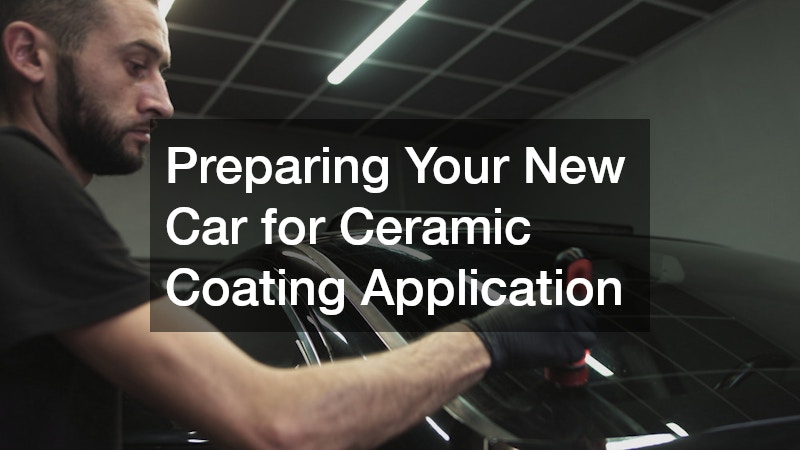Understanding the importance of auto ceramic coating and the optimal timing for application on new cars is vital for maintaining the pristine condition of your vehicle. A ceramic coating provides long-lasting protection and enhances the visual appeal of your car. This article explores what ceramic coating is, compares it with other options, and delves into the timing and methods of application for new cars.
What is Auto Ceramic Coating?
Definition and Benefits
Ceramic coating is a liquid polymer applied to the exterior surfaces of a vehicle to provide a protective layer. The benefits of ceramic coatings include superior protection against environmental damage such as UV rays, corrosion, and chemical stains. It also enhances the aesthetic appeal of your car by adding a glossy finish, making maintenance easier as dirt and grime slide off the surface.
Unlike traditional waxes and sealants, ceramic coatings form a semi-permanent bond with the vehicle’s paint, offering a longer-lasting solution. This bonding creates a durable barrier that resists numerous contaminants and minimizes maintenance efforts for the car owner. Additionally, the hydrophobic properties of ceramic coatings result in improved water beading and reduced water spot accumulation.
Another significant advantage of ceramic coatings is their enhancement of the paint’s reflective properties, leading to a profound shine. This ensures that a car looks vibrant and fresh, preserving its showroom-quality appearance. Moreover, a correctly applied ceramic coating can increase a vehicle’s potential resale value by maintaining its exterior condition.
Comparison with Other Coating Options
Ceramic coatings stand out when compared to traditional waxes and sealants due to their longevity and durability. While waxes may require reapplication every few months, ceramic coatings can last several years with proper maintenance. In addition, ceramic coatings offer superior resistance to environmental stressors, which waxes and sealants cannot equally provide.
Sealants generally last longer than waxes, about six months, but still don’t match the durability of ceramic coatings. The molecular structure of ceramic coatings allows them to provide a tougher and more resilient layer of protection. This is crucial for car owners who live in harsh climates or frequently drive through challenging conditions where road salts and environmental pollutants are prevalent.
While initial costs for ceramic coatings might be higher than those of waxes and sealants, their lasting effects offer better value over time. Vehicle owners can save time and money on frequent reapplication and detailing services. Additionally, ceramic coatings create a more notable enhancement in the paint’s visual appeal, providing a lustrous look that traditional methods fail to achieve.
The Best Time to Apply Ceramic Coating on a New Car
Initial Assessment of New Car Condition
Before applying a ceramic coating to a new car, it’s essential to conduct a thorough assessment of the paintwork’s condition. Even brand-new vehicles can have minor imperfections or contaminants on the paint surface. It’s crucial to look for issues such as swirl marks, uneven texture, or small scratches that need addressing before coating application.
It is advisable to check for any factory-applied sealants or dealer-applied products as well. Removing these prior to the ceramic coating process will ensure optimal bonding and effectiveness of the coating. A meticulous inspection and correction process will result in the most satisfactory results for the coating application.
Optimal Timing for Application
The first few weeks to months after a new car purchase are ideal for ceramic coating application. During this time, the vehicle has likely incurred minimal damage, and the factory paint is still in excellent condition. Early application helps to preserve the new car’s original appearance from environmental hazards such as bird droppings, tree sap, and chemical contaminants.
Applying the coating early also reduces the risk of swirl and scratch formation during regular washing and detailing. The ceramic layer safeguards against these common issues, resulting in less frequent paint correction needs and maintaining the vehicle’s value. Additionally, getting the coating early helps car owners avoid accidental damage that can occur over time if left unprotected.
Preparing Your New Car for Ceramic Coating Application
Proper cleaning and surface preparation is critical to the successful application of a ceramic coating. Washing the car thoroughly with a pH-neutral shampoo removes dirt, road grime, and previous wax layers. Following the wash, a clay bar treatment should be used to extract any deeply embedded contaminants such as tar, sap, or industrial fallout that washing alone cannot remove.
After cleaning, it’s important to polish the car if necessary to remove any minor scratches or swirl marks. Proper polishing creates a smooth surface, enhancing the bonding ability of the ceramic coating. Completing this preparation process will ensure the coating adheres perfectly, maximizing its durability and effectiveness against potential damage.
Finally, the car’s surface should be wiped down with a special cleaner or isopropyl alcohol to remove any remaining oils or residues. This step guarantees a pristine surface for the ceramic coating to bond with. Precision in preparation and following recommended guidelines will result in a flawless application and superior finish.
Auto ceramic coating offers substantial protection and aesthetic benefits for new cars when applied at the optimal time. A detailed understanding of ceramic coating properties, its comparison with other options, and the meticulous preparation involved can empower car owners to make informed decisions. Choosing the right moment and method for applying ceramic coating will enhance a vehicle’s durability, appearance, and value for years to come.



